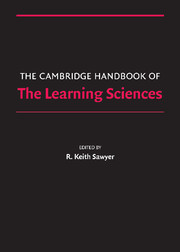Book contents
- Frontmatter
- Contents
- Preface
- Contributors
- 1 Introduction
- PART I FOUNDATIONS
- PART II METHODOLOGIES
- PART III THE NATURE OF KNOWLEDGE
- 14 Case-Based Reasoning
- 15 The Knowledge Integration Perspective on Learning and Instruction
- 16 A History of Conceptual Change Research
- 17 Spatial Representations and Imagery in Learning
- 18 Literacy and the Learning Sciences
- PART IV MAKING KNOWLEDGE VISIBLE
- PART V LEARNING TOGETHER
- PART VI LEARNING ENVIRONMENTS
- Afterword: After How Comes What
- Epilogue: The Fundamental Issue in the Learning Sciences
- Author Index
- Subject Index
- References
17 - Spatial Representations and Imagery in Learning
Published online by Cambridge University Press: 05 June 2012
- Frontmatter
- Contents
- Preface
- Contributors
- 1 Introduction
- PART I FOUNDATIONS
- PART II METHODOLOGIES
- PART III THE NATURE OF KNOWLEDGE
- 14 Case-Based Reasoning
- 15 The Knowledge Integration Perspective on Learning and Instruction
- 16 A History of Conceptual Change Research
- 17 Spatial Representations and Imagery in Learning
- 18 Literacy and the Learning Sciences
- PART IV MAKING KNOWLEDGE VISIBLE
- PART V LEARNING TOGETHER
- PART VI LEARNING ENVIRONMENTS
- Afterword: After How Comes What
- Epilogue: The Fundamental Issue in the Learning Sciences
- Author Index
- Subject Index
- References
Summary
Spatial representations, when used well, support learning in reading, mathematics, and science. They also enable mental simulations and visualizations that prompt innovation and scientific discovery. Spatial representations, both external drawings and internal images, exploit people's sophisticated perceptual-motor system. The embodiment of thought in perceptual processes has promising implications for learning. In this chapter, we emphasize spatial representations that people construct and transform in their mind's eye. The process of working with these mental spatial representations is called imagery.
Spatial representation is different from other forms of cognitive representation studied by learning scientists – linguistic, conceptual, logical – because spatial representations partake of perceptual processes and experiences. Neurological evidence, for example, indicates that perceptual regions of the brain activate when people imagine movement (Kosslyn, 1994). Yet, spatial representations are not mere echoes of perception. They can integrate nonperceptual knowledge that allows people to imagine things they have not seen. Spatial representations have four key properties that determine their unique value for education. We begin with a brief review of early psychological research on spatial memory, and then describe the four key properties. We show how these properties can be used to help people learn about the world through mental models and simulations. Afterward, we discuss ways to help people leverage imagery to innovate new ideas and scientific insight.
- Type
- Chapter
- Information
- The Cambridge Handbook of the Learning Sciences , pp. 283 - 298Publisher: Cambridge University PressPrint publication year: 2005
References
- 14
- Cited by



